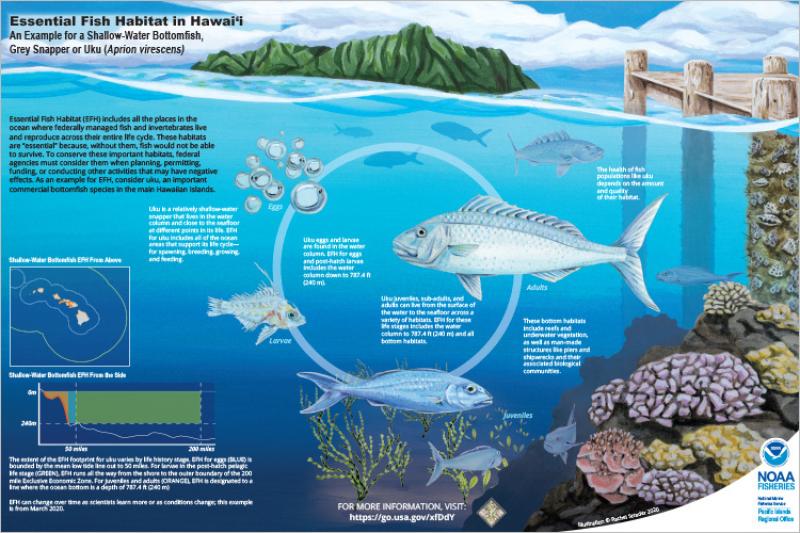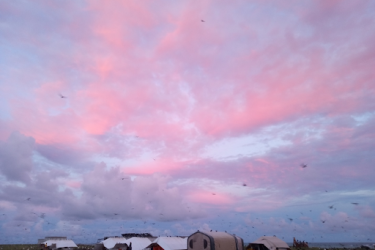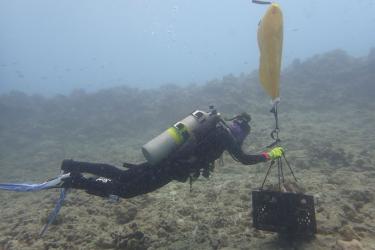Throughout all phases of their lives, fish and invertebrates depend on healthy habitat to thrive. NOAA Fisheries recently developed an innovative scientific illustration that shows how various habitat features support different life stages of a fish—uku, or grey snapper (Aprion virescens), in this example.
Available as a poster, the illustration highlights key aspects of essential fish habitat (EFH), which are areas necessary for federally managed fish and other organisms, including uku, to reproduce and survive. Uku is a popular and commercially-important fish in Hawaiʻi. Defining and protecting the ecosystems vital to uku and other fish through a regulatory process, such as EFH, formally establishes where the habitats are located. This allows NOAA Fisheries to work with partner agencies to reduce negative impacts to the habitats, helping to maintain and conserve their critical functions.
NOAA Fisheries strives to not only protect and conserve EFH but also communicate its importance to stakeholders and the public. The new scientific illustration achieves this goal with flying—and scientifically accurate—colors.
Visualizing Science Through Art
To create the informative poster, we stepped away from our technical reports to collaborate with an artist, Rachel Strader. We combined our fisheries science and management knowledge with the artist's scientific illustration skills.
Scientific illustration can depict any aspect of science, helping scientists communicate complex concepts in engaging, easy-to-understand ways. For example, a scientific illustration may show the biology of a microscopic organism, describe a delicate medical procedure, or render the form of a long-extinct animal housed in a museum exhibit.
Our science-and-art partnership resulted in a technically accurate, yet beautifully crafted illustration of uku and the habitat on which it depends. This image would have been challenging to capture with a single or even a series of photographs, as the life of uku spans a wide array of depths and ecosystems. To design the individual elements of the poster, Strader used multiple reference photos of uku and their habitat provided by NOAA Fisheries scientists. This allowed her to create a technically correct and visually appealing depiction of uku EFH.
The picture above shows a close-up photo of a larval uku that helped Strader incorporate details of the fish’s physiology and coloration. Taking cues from photos of corals and sea grasses, she then produced detailed drawings of individual blades of the endemic Hawaiian seagrass (Halophila hawaiiana); various coral colonies, including cauliflower coral (Pocillopora meandrina); and the Hawaiian oyster (Dendostrea sandvicensis) growing on the pier piling. Next, she painted each fish, invertebrate, and other habitat element, painstakingly matching the hues in her art to those in the reference photos.
Why Illustrating EFH Matters
Visual representations of EFH—such as this illustration of an uku in a healthy habitat—are useful to anyone interested in understanding the importance of protecting these habitats. But they're also useful to various federal agencies.
EFH conservation and protection requires biologists at NOAA Fisheries to consult with federal partners and examine their projects within the EFH footprint that may adversely affect habitat. We provide federal partners with conservation recommendations to help them avoid sensitive habitats, minimize adverse effects of the project, and provide compensation measures for natural resources that may be unavoidably lost while completing their project. For example, projects can avoid physical damage to EFH by working from shore whenever possible and minimizing sedimentation by using turbidity curtains (constructing a barrier around the worksite so that sediment is contained).
Defining EFH and establishing best management practices to help avoid, minimize, or offset adverse impacts of a project directly benefits coastal and nearshore habitats, as well as the species that depend on them, like the uku.
While EFH consultations often produce highly detailed and complex technical reports, this partnership and poster is a vivid example of how a picture is worth a thousand words.






